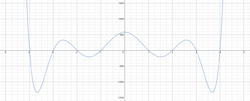Octic equation

In algebra, an octic equation[1] is an equation of the form
- [math]\displaystyle{ ax^8+bx^7+cx^6+dx^5+ex^4+fx^3+gx^2+hx+k=0,\, }[/math]
where a ≠ 0.
An octic function is a function of the form
- [math]\displaystyle{ f(x)=ax^8+bx^7+cx^6+dx^5+ex^4+fx^3+gx^2+hx+k, }[/math]
where a ≠ 0. In other words, it is a polynomial of degree eight. If a = 0, then f is a septic function (b ≠ 0), sextic function (b = 0, c ≠ 0), etc.
The equation may be obtained from the function by setting f(x) = 0.
The coefficients a, b, c, d, e, f, g, h, k may be either integers, rational numbers, real numbers, complex numbers or, more generally, members of any field.
Since an octic function is defined by a polynomial with an even degree, it has the same infinite limit when the argument goes to positive or negative infinity. If the leading coefficient a is positive, then the function increases to positive infinity at both sides; and thus the function has a global minimum. Likewise, if a is negative, the octic function decreases to negative infinity and has a global maximum. The derivative of an octic function is a septic function.
Solvable octics
By the Abel–Ruffini theorem, there is no general algebraic formula for a solution of an octic equation in terms of its parameters. However, some sub-classes of octics do have such formulas.
Trivially, octics of the form
- [math]\displaystyle{ x^8=a }[/math]
with positive a have the solutions
- [math]\displaystyle{ x_k=a^{1/8}\omega_k\, , \quad k=1, \dots , 8, }[/math]
where [math]\displaystyle{ \omega_k }[/math] is the k-th eighth root of 1 in the complex plane.
Octics which can be decomposed as a functional composition of solvable polynomials can be solved. For example, octics of the form
- [math]\displaystyle{ ax^8+ex^4+k=0 }[/math]
are compositions of a quadratic and x4. Octics of the form
- [math]\displaystyle{ ax^8 +cx^6+ex^4+gx^2+k=0 }[/math] are compositions of a quartic and x2.
Application
In some cases some of the quadrisections (partitions into four regions of equal area) of a triangle by perpendicular lines are solutions of an octic equation.[2]
See also
References
- ↑ James Cockle proposed the names "sexic", "septic", "octic", "nonic", and "decic" in 1851. (Mechanics Magazine, Vol. LV, p. 171)
- ↑ http://forumgeom.fau.edu/FG2018volume18/FG201802.pdf Carl Eberhart, “Revisiting the quadrisection problem of Jacob Bernoulli”, Forum Geometricorum 18, 2018, pp. 7–16 (particularly pp. 14–15).

